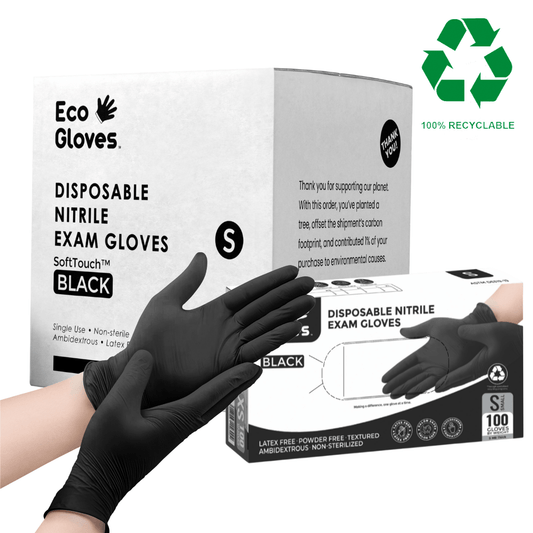The In-Depth Guide to Disposable Gloves: Understanding Their Usage and Environmental Impact
Eco Gloves
Introduction
In the realm of health and safety, disposable gloves are indispensable. They serve as the first line of defense, protecting us from a myriad of hazards, from harmful chemicals to infectious diseases. However, as we become increasingly aware of our environmental footprint, the impact of these single-use items has come under scrutiny. This comprehensive guide will delve into the world of disposable gloves, exploring their usage, their environmental footprint, and the steps we can take towards a more sustainable future.
Topics Covered
- Understanding Disposable Gloves
- Choosing the Right Gloves
- The Environmental Impact of Disposable Gloves
- Key Takeaways: Disposable Gloves Usage & Environmental Impact
- Frequently Asked Questions About Disposable Gloves
Understanding Disposable Gloves
Disposable gloves are a type of personal protective equipment (PPE) used to protect the hands from exposure to potential hazards. They are typically made from different types of materials, each with its unique properties and uses. The choice of glove material depends on the task at hand and the potential hazards involved.
Nitrile Gloves
Nitrile gloves are made from synthetic rubber and are favored for their high puncture resistance. They are latex-free, making them a suitable choice for people with latex allergies. Nitrile gloves are commonly used in medical settings and laboratories due to their superior resistance to a wide range of chemicals. They are also more resistant to oils and certain solvents than latex gloves, making them a popular choice in automotive, janitorial, and food industries.
Latex Gloves
Made from natural rubber latex, these gloves are known for their flexibility and comfort. They offer excellent tactile sensitivity, making them ideal for precision tasks. However, they can cause allergic reactions in some individuals, ranging from skin irritation to anaphylaxis in severe cases. Despite this, they are widely used in the medical field and other industries that require manual dexterity.
Vinyl Gloves
Vinyl gloves are a cost-effective choice for tasks requiring frequent glove changes. They are less durable than nitrile and latex gloves but are latex-free, making them a suitable option for people with latex allergies. They are commonly used in food service and other industries where high levels of durability and protection are not required.
Neoprene Gloves
Neoprene gloves offer good tensile strength and heat resistance. They are compatible with many acids, caustics, and oils, making them a good choice for handling hazardous chemicals. They also offer good flexibility and comfort, similar to latex gloves.
Butyl Gloves
Butyl gloves offer the highest resistance to permeation by most gases and water vapor. They are especially suitable for use with esters and ketones. These gloves are often used in industries that handle hazardous chemicals, such as the nuclear industry.
Choosing the Right Gloves
Choosing the right gloves is a critical aspect of ensuring safety. Several factors should be considered when selecting a glove:
- Degradation Rating
- Breakthrough Time
- Permeation Rate
- Thickness
- Length
- Size
Always consult the Safety Data Sheet (SDS) of the chemicals you're handling to verify the glove's chemical compatibility.
The Environmental Impact of Disposable Gloves
While disposable gloves are essential for safety, their environmental impact cannot be ignored. Most disposable gloves are not biodegradable and can take hundreds of years to decompose in landfills. The production process of these gloves also contributes to pollution and resource depletion.
However, manufacturers are now producing eco-friendly alternatives, such as biodegradable nitrile gloves. These gloves decompose in landfills much faster than traditional nitrile gloves, reducing their environmental impact. Biodegradable gloves are made with an organic additive that attracts microbial activity in the landfill. These microbes consume the gloves, breaking them down into natural substances like water, carbon dioxide, and biomass.
Conclusion
Disposable gloves are a crucial component of safety in many industries. However, it's important to choose the right gloves for your needs and to consider their environmental impact. By understanding the different types of gloves and their properties, you can make informed decisions that protect both you and the environment. As we move towards a more sustainable future, consider opting for biodegradable alternatives where possible. Remember, every small step counts towards making a big difference.
Key Takeaways: Disposable Gloves Usage & Environmental Impact
-
Variety of Materials for Different Needs: Nitrile, latex, vinyl, neoprene, and butyl gloves each offer distinct benefits and limitations depending on the task and hazards involved.
-
Nitrile as a Popular Choice: Offers superior puncture and chemical resistance, is latex-free, and is widely used in healthcare, labs, and industrial applications.
-
Latex for Dexterity: Provides excellent comfort and tactile sensitivity but can trigger allergic reactions in some users.
-
Vinyl for Cost Efficiency: Suitable for tasks with frequent glove changes, though less durable and protective than nitrile or latex.
-
Specialty Gloves for Hazardous Chemicals: Neoprene and butyl gloves provide enhanced resistance against specific chemicals and extreme conditions.
-
Proper Selection Ensures Safety: Factors like degradation rating, breakthrough time, permeation rate, glove thickness, and correct sizing are critical for protection.
👉 Choosing the right disposable glove helps balance safety, performance, and environmental considerations for your specific industry or task.
Frequently Asked Questions About Disposable Gloves
-
What are the main types of disposable gloves?
Nitrile, latex, vinyl, neoprene, and butyl gloves—each suited for different applications and hazard levels.
-
Which disposable glove is best for chemical resistance?
Butyl gloves offer the highest resistance to gases and many chemicals, while neoprene also provides strong resistance to acids, caustics, and oils.
-
Why choose nitrile gloves over latex?
Nitrile gloves are latex-free, puncture-resistant, and chemically resistant, making them a safer option for allergy-sensitive users.
-
When should vinyl gloves be used?
For low-risk tasks requiring frequent glove changes, such as in food service, where durability is less critical.
-
How do I choose the right glove for my job?
Consider the glove’s chemical compatibility, degradation rating, breakthrough time, permeation rate, thickness, length, and proper sizing.















